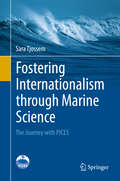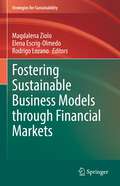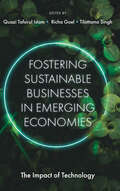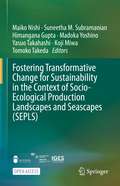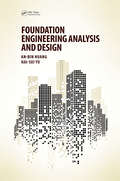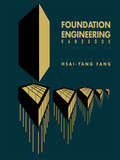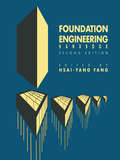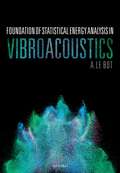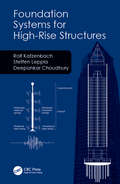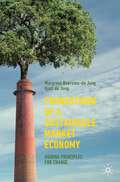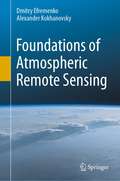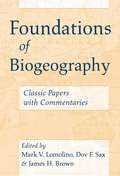- Table View
- List View
Fossils at a Glance
by Clare Milsom Sue RigbyLife on Earth has been evolving and interacting with the surface and atmosphere for almost four billion years. Fossils provide a powerful tool in the study of the Earth and its history. They also provide important data for evolutionary studies and contribute to our understanding of the extinction of organisms and the origins of modern biodiversity. Introduces the study of fossils in a simple and straightforward manner. Short chapters introduce the main topics in the current study of fossils. The most important fossil groups are discussed, from microfossils through invertebrates to vertebrates and plants, followed by a brief narrative of life on earth. Diagrams are central to the book and allow the reader to see most of the important data 'at a glance'. Each topic covers two pages and provides a self-contained suite of information or a starting point for future study.
Fostering Internationalism through Marine Science: The Journey with PICES
by Sara TjossemThis book describes the work of the North Pacific Marine Science Organization (PICES) since its launch 1992. Mapping the evolution of its agenda gives insight into the development of modern marine science in the context of competing demands of stakeholders within and outside the organization. The opening chapter consider the challenges of marine science as a large scale, and places PICES in the contexts of internationalism and science-based resource management. They also lay out the organization’s longstanding focus on the development of climate science and its applications. Subsequent chapters explore the pros and cons of national vs. international science, negotiating the nature of investigation and cooperation across scientific, political and institutional boundaries in the region; national perspectives on purpose, scope, and mandates; assessing two major initiatives undertaken to date; the challenges of incorporating social science into an organization of mainly natural scientists.
Fostering Long-Term Sustainable Development in Africa: Overcoming Poverty, Inequality, and Unemployment
by David Mhlanga Mufaro DzingiraiThis book provides a broad and insightful guide to the economic, social, and environmental concerns seen within Africa. It highlights the central economic challenges faced by African countries and outlines ways in which long-term sustainable development in Africa can be achieved. A particular focus in given to issues of poverty, inequality, and unemployment and how poor infrastructure, limited healthcare and education, and environmental deterioration are exacerbating these issues. By looking at the limited effectiveness of traditional development initiatives, a new framework for economic development is presented that focuses on community ownership and long-term sustainability and which acknowledges the history of colonisation, economic exploitation, and political instability that has held Africa back in the past.This book takes hope from countries within the Global South that have moved towards sustainable development and sets out ways in which other countries can follow them. It will be relevant to students, researchers, and policymakers interested in development and environmental economics.
Fostering Sustainable Business Models through Financial Markets (Strategies for Sustainability)
by Magdalena Ziolo Elena Escrig-Olmedo Rodrigo LozanoThe aim of this volume is to foster more sustainable business models through financial markets. To that end, it is necessary to know the main global challenges facing financial markets and their impact on creating sustainable value in business models of enterprises in the context of sustainable adaptation. The book focuses on assessing the decision criteria adopted by financial markets in the process of transaction risk valuation, in terms of the presence of Environmental, Social, and Governance (ESG) criteria, and by assessing the impact of including these criteria in the risk assessment process by financial markets in business decisions, leading as a consequence to building new value in the form of a sustainable business model. The book presents global ESG risks facing the financial markets, and discusses how ESG risks are managed and monitored, and how financial markets can measure and operationalize extra-financial risks in its assessment process. The book also analyses ESG risk implications and influences on company behavior, and the actions that companies should take considering the ESG assessment requirements of financial markets. Finally, it provides a comprehensive, structured, and systematic view of how financial markets and companies should adapt and improve their business models. The book provides unique challenges for investors, companies, financial markets, and for our society as a whole, advancing traditional risk management approaches to address global risks.
Fostering Sustainable Businesses in Emerging Economies: The Impact of Technology
by Quazi Tafsirul Islam Richa Goel Tilottama SinghFostering Sustainable Businesses in Emerging Economies presents a series of case studies and exploratory studies, using quantitative analysis, scientific studies, and qualitative studies showing how innovation and technology enable emerging economies to achieve business sustainability and also achieve the Sustainable Development Goals (SDGs). Most of all, the authors answer the question: What are the most important lessons policymakers need to consider when promoting sustainable business development?
Fostering Sustainable Businesses in Emerging Economies: The Impact of Technology
by QUAZI TAFSIRUL ISLAM, RICHA GOEL AND TILOTTAMA SINGHFostering Sustainable Businesses in Emerging Economies presents a series of case studies and exploratory studies, using quantitative analysis, scientific studies, and qualitative studies showing how innovation and technology enable emerging economies to achieve business sustainability and also achieve the Sustainable Development Goals (SDGs). Most of all, the authors answer the question: What are the most important lessons policymakers need to consider when promoting sustainable business development?
Fostering Sustainable Development in the Age of Technologies
by Rohit Sharma, Anjali Shishodia, Ashish GuptaThe world is changing at an unprecedented pace and organizations worldwide are finding it difficult to match their operational efficiency and sustainable development targets with the United Nations Sustainable Development Goals (UNSDGs). Due to massive scarcity of resources, global supply chains are under immense pressure, leading to social, economic, and environmental challenges. Holistic sustainable development across social, economic, and environmental dimensions to create an equitable society varies widely in its efficiency towards creating a resilient and inclusive future. Fostering Sustainable Development in the Age of Technologies highlights the interplay between various disruptive technologies such as Artificial Intelligence, Autonomous robots, Big Data Analytics, Blockchain, Cloud Computing, and Digital Twins, and holistic sustainable development. In the highly dynamic business environment, there is an urgent need to catch up with the paradigm shift being created using these technologies. The studies brought together here emphasise how various disruptive technologies can aid in sustainable development, offering possible strategies to help tackle the challenges we face today and embrace the new normal. Collaboration, adaptation, and continuous learning hold the key in overcoming the grand societal challenges and maintaining a balance between social, economic, and environmental dimensions. This edited collection appeals to a wide range of academics and professionals including graduate, postgraduate, and PhD research scholars, and faculty members in the areas of International Management, International Business, International Marketing, Finance, Human Resources and Corporate Governance. They are also of interest to Government Agencies, Practicing Managers, Research Agencies, and Libraries of Business Management Colleges and Universities.
Fostering Sustainable Development in the Age of Technologies
by Rohit Sharma Anjali Shishodia Ashish GuptaThe world is changing at an unprecedented pace and organizations worldwide are finding it difficult to match their operational efficiency and sustainable development targets with the United Nations Sustainable Development Goals (UNSDGs). Due to massive scarcity of resources, global supply chains are under immense pressure, leading to social, economic, and environmental challenges. Holistic sustainable development across social, economic, and environmental dimensions to create an equitable society varies widely in its efficiency towards creating a resilient and inclusive future. Fostering Sustainable Development in the Age of Technologies highlights the interplay between various disruptive technologies such as Artificial Intelligence, Autonomous robots, Big Data Analytics, Blockchain, Cloud Computing, and Digital Twins, and holistic sustainable development. In the highly dynamic business environment, there is an urgent need to catch up with the paradigm shift being created using these technologies. The studies brought together here emphasise how various disruptive technologies can aid in sustainable development, offering possible strategies to help tackle the challenges we face today and embrace the new normal. Collaboration, adaptation, and continuous learning hold the key in overcoming the grand societal challenges and maintaining a balance between social, economic, and environmental dimensions. This edited collection appeals to a wide range of academics and professionals including graduate, postgraduate, and PhD research scholars, and faculty members in the areas of International Management, International Business, International Marketing, Finance, Human Resources and Corporate Governance. They are also of interest to Government Agencies, Practicing Managers, Research Agencies, and Libraries of Business Management Colleges and Universities.
Fostering Transformative Change for Sustainability in the Context of Socio-Ecological Production Landscapes and Seascapes (SEPLS)
by Maiko Nishi Suneetha M. Subramanian Himangana Gupta Madoka Yoshino Yasuo Takahashi Koji Miwa Tomoko TakedaThis open access book is a compilation of case studies that provide useful knowledge and lessons that derive from on-the-ground activities and contribute to policy recommendations, focusing on the relevance of social-ecological production landscapes and seascapes (SEPLS) to “transformative change.” The concept of “transformative change” has been gaining more attention to deal with today’s environmental and development problems, whereas both policy and scientific communities have been increasingly calling for transformative change toward sustainable society. The Intergovernmental Science-Policy Platform on Biodiversity and Ecosystem Services (IPBES) has planned to start the so-called “assessment on transformative change” if approved by the IPBES plenary to be held in 2021. At present, the idea of transformative change, including its scope, methodologies, approaches and strategies, are yet to be clarified. By bringing together all of the different concerns and interests in the land/seascape, SEPLS approaches could provide practical and experience-based insights for understanding and gauging transformative change and identifying determinants of such change. This book explores how SEPLS management relates to the idea of transformative change to further the discussion of sustainable transitions in advancing sustainability science. The introductory chapter is followed by case study chapters offering real-world examples of transformative change as well as a synthesis chapter clarifying the relevance of the case study findings to policy and academic discussions. It will be of interest to scholars, policymakers and professionals in the fields related to sustainable development.
Foundation and Forensic Geotechnical Engineering: Proceedings of the Indian Geotechnical Conference 2021 Volume 2 (Lecture Notes in Civil Engineering #295)
by Kasinathan Muthukkumaran C. N. V. Satyanarayana Reddy Anil Joseph S. SenthamilkumarThis book comprises the select peer-reviewed proceedings of the Indian Geotechnical Conference (IGC) 2021. The contents focus on Geotechnics for Infrastructure Development and Innovative Applications. This book covers topics related to shallow foundations, pile & piled raft foundation, geotechnical design of foundation, wind turbine foundation, foundations on problematic soils, forensic geotechnical engineering, and case studies on geotechnical failures. This book is of interest to those in academia and industry.
Foundation Engineering Analysis and Design
by An-Bin Huang Hai-Sui YuOne of the core roles of a practising geotechnical engineer is to analyse and design foundations. This textbook for advanced undergraduates and graduate students covers the analysis, design and construction of shallow and deep foundations and retaining structures as well as the stability analysis and mitigation of slopes. It progressively introduces critical state soil mechanics and plasticity theories such as plastic limit analysis and cavity expansion theories before leading into the theories of foundation, lateral earth pressure and slope stability analysis. On the engineering side, the book introduces construction and testing methods used in current practice. Throughout it emphasizes the connection between theory and practice. It prepares readers for the more sophisticated non-linear elastic-plastic analysis in foundation engineering which is commonly used in engineering practice, and serves too as a reference book for practising engineers. A companion website provides a series of Excel spreadsheet programs to cover all examples included in the book, and PowerPoint lecture slides and a solutions manual for lecturers. Using Excel, the relationships between the input parameters and the design and analysis results can be seen. Numerical values of complex equations can be calculated quickly. non-linearity and optimization can be brought in more easily to employ functioned numerical methods. And sophisticated methods can be seen in practice, such as p-y curve for laterally loaded piles and flexible retaining structures, and methods of slices for slope stability analysis.
Foundation Engineering Analysis and Design
by An-Bin Huang Hai-Sui YuOne of the core roles of a practising geotechnical engineer is to analyse and design foundations. This textbook for advanced undergraduates and graduate students covers the analysis, design and construction of shallow and deep foundations and retaining structures as well as the stability analysis and mitigation of slopes. It progressively introduces critical state soil mechanics and plasticity theories such as plastic limit analysis and cavity expansion theories before leading into the theories of foundation, lateral earth pressure and slope stability analysis. On the engineering side, the book introduces construction and testing methods used in current practice. Throughout it emphasizes the connection between theory and practice. It prepares readers for the more sophisticated non-linear elastic-plastic analysis in foundation engineering which is commonly used in engineering practice, and serves too as a reference book for practising engineers. A companion website provides a series of Excel spreadsheet programs to cover all examples included in the book, and PowerPoint lecture slides and a solutions manual for lecturers. Using Excel, the relationships between the input parameters and the design and analysis results can be seen. Numerical values of complex equations can be calculated quickly. non-linearity and optimization can be brought in more easily to employ functioned numerical methods. And sophisticated methods can be seen in practice, such as p-y curve for laterally loaded piles and flexible retaining structures, and methods of slices for slope stability analysis.
Foundation Engineering Handbook
by Hsai-Yang FangMore than ten years have passed since the first edition was published. During that period there have been a substantial number of changes in geotechnical engineering, especially in the applications of foundation engineering. As the world population increases, more land is needed and many soil deposits previously deemed unsuitable for residential housing or other construction projects are now being used. Such areas include problematic soil regions, mining subsidence areas, and sanitary landfills. To overcome the problems associated with these natural or man-made soil deposits, new and improved methods of analysis, design, and implementation are needed in foundation construction. As society develops and living standards rise, tall buildings, transportation facilities, and industrial complexes are increasingly being built. Because of the heavy design loads and the complicated environments, the traditional design concepts, construction materials, methods, and equipment also need improvement. Further, recent energy and material shortages have caused additional burdens on the engineering profession and brought about the need to seek alternative or cost-saving methods for foundation design and construction.
Foundation Engineering Handbook
by Hsai-Yang FangMore than ten years have passed since the first edition was published. During that period there have been a substantial number of changes in geotechnical engineering, especially in the applications of foundation engineering. As the world population increases, more land is needed and many soil deposits previously deemed unsuitable for residential housing or other construction projects are now being used. Such areas include problematic soil regions, mining subsidence areas, and sanitary landfills. To overcome the problems associated with these natural or man-made soil deposits, new and improved methods of analysis, design, and implementation are needed in foundation construction. As society develops and living standards rise, tall buildings, transportation facilities, and industrial complexes are increasingly being built. Because of the heavy design loads and the complicated environments, the traditional design concepts, construction materials, methods, and equipment also need improvement. Further, recent energy and material shortages have caused additional burdens on the engineering profession and brought about the need to seek alternative or cost-saving methods for foundation design and construction.
Foundation of Statistical Energy Analysis in Vibroacoustics
by A. Le BotThis book provides an in-depth study of the foundations of statistical energy analysis, with a focus on examining the statistical theory of sound and vibration. In the modal approach, an introduction to random vibration with application to complex systems having a large number of modes is provided. For the wave approach, the phenomena of propagation, group speed, and energy transport are extensively discussed. Particular emphasis is given to the emergence of the diffuse field, the central concept of the theory. All important notions are gradually introduced—-making the text self-contained—-to lead the reader to the ultimate result of `coupling power proportionality' and the concept of `vibrational temperature'. Further key topics include the analogy between thermodynamics and sound vibration. Applications are concerned with random vibration in mass—spring resonators, strings, beams, rods, and plates but also reverberation in room acoustics, radiation of sound, and sound response.
Foundation Systems for High-Rise Structures
by Rolf Katzenbach Steffen Leppla Deepankar ChoudhuryThe book deals with the geotechnical analysis and design of foundation systems for high-rise buildings and other complex structures with a distinctive soil-structure interaction. The basics of the analysis of stability and serviceability, necessary soil investigations, important technical regulations and quality and safety assurance are explained and possibilities for optimised foundation systems are given. Additionally, special aspects of foundation systems such as geothermal activated foundation systems and the reuse of existing foundations are described and illustrated by examples from engineering practice.
Foundation Systems for High-Rise Structures
by Rolf Katzenbach Steffen Leppla Deepankar ChoudhuryThe book deals with the geotechnical analysis and design of foundation systems for high-rise buildings and other complex structures with a distinctive soil-structure interaction. The basics of the analysis of stability and serviceability, necessary soil investigations, important technical regulations and quality and safety assurance are explained and possibilities for optimised foundation systems are given. Additionally, special aspects of foundation systems such as geothermal activated foundation systems and the reuse of existing foundations are described and illustrated by examples from engineering practice.
Foundations and Practice of Research: Adventures with Dooyeweerd's Philosophy (Routledge Advances in Research Methods)
by Andrew BasdenMany of the issues on which meaningful research is founded are seldom discussed; for example, the role of everyday experience, diversity and coherence of meaning in the world, the meaningfulness and wider mandate of research, the very nature and validity of theoretical thought, and the deep presuppositions of philosophy and how they undermine the success of research. Such questions are material to the philosophies that guide research thinking in all fields, and since they cannot be satisfactorily addressed in a piecemeal fashion, this book employs the radically different philosophy of Herman Dooyeweerd to consider them together. Parts I and II discuss these issues theoretically and philosophically, while Part III discusses them practically, specifically the adventures that researchers across the world have had using Dooyeweerd's philosophy. Foundations and Practice of Research assembles a wide range of experiences of using Dooyeweerd's philosophy in research in the fields of mathematics, the natural sciences, the social sciences, design sciences and the humanities. Case studies demonstrate how Dooyeweerd's philosophy has been found fruitful in most stages of research, and the philosophical discussion backs this up. This book challenges researchers to join the adventures, including suggestions of potential research that could be carried out, as well as questions still left unanswered.
Foundations and Practice of Research: Adventures with Dooyeweerd's Philosophy (Routledge Advances in Research Methods)
by Andrew BasdenMany of the issues on which meaningful research is founded are seldom discussed; for example, the role of everyday experience, diversity and coherence of meaning in the world, the meaningfulness and wider mandate of research, the very nature and validity of theoretical thought, and the deep presuppositions of philosophy and how they undermine the success of research. Such questions are material to the philosophies that guide research thinking in all fields, and since they cannot be satisfactorily addressed in a piecemeal fashion, this book employs the radically different philosophy of Herman Dooyeweerd to consider them together. Parts I and II discuss these issues theoretically and philosophically, while Part III discusses them practically, specifically the adventures that researchers across the world have had using Dooyeweerd's philosophy. Foundations and Practice of Research assembles a wide range of experiences of using Dooyeweerd's philosophy in research in the fields of mathematics, the natural sciences, the social sciences, design sciences and the humanities. Case studies demonstrate how Dooyeweerd's philosophy has been found fruitful in most stages of research, and the philosophical discussion backs this up. This book challenges researchers to join the adventures, including suggestions of potential research that could be carried out, as well as questions still left unanswered.
Foundations for Innovative Application of Airborne Radars: Measuring the Water Surface Backscattering Signature and Wind (SpringerBriefs in Earth Sciences)
by Alexey NekrasovThe ‘wind vector’ – wind speed and direction – is a main meteorological quantity and relevant for air-sea exchange processes. This book explores the use of several airborne microwave instruments, some of which are part of standard aircraft equipment, in determining the local wind vector over water. This is worthwhile as local wind information is usually only available at measurements sites like weather stations and airports, and global wind information from satellites has very coarse resolution and poor temporal coverage – at most a few times daily. In his book, Nekrasov uses known results in a novel way and gives explicit and application-oriented descriptions how to additionally retrieve local wind information from standard airborne microwave instruments. The results presented here are highly valuable for flight operation above the sea (e.g., search-and-rescue) but also for complementing other measurements of atmospheric or oceanic parameters during research flights.
Foundations of a Sustainable Economy: Moral, Ethical and Religious Perspectives (Finance, Governance and Sustainability)
by Umar BurkiThis book addresses current practices related to sustainable development, its challenges and the future. People belonging to different genders regardless of their age, social class and education should be equal as citizens and individuals, and identical in their rights and responsibilities. The business sector, authorities, societies and religious circles have the potential to play a fundamental role in curbing social ills and the degradation of the environment in this modern world. The authors of this book argue that without good governance, the status of a human being is unlikely to improve. They make the case that to achieve sustainability, government, society and the economy must ensure a platform for people to participate in decision-making and benefit from the rights they are accorded. By covering a range of perspectives across economic, social and moral life, the book will shed light on the problems and possible solutions to sustainable development and the triple bottom line, of people, planet and profit, under the umbrella of morals and divine law. This will be a useful guide for undergraduate and postgraduate students across multiple disciplines, such as economics, religious studies, business studies, political science, anthropology and sociology.
Foundations of a Sustainable Economy: Moral, Ethical and Religious Perspectives (Finance, Governance and Sustainability)
by Umar Burki Toseef Azid Robert Francis DahlstromThis book addresses current practices related to sustainable development, its challenges and the future. People belonging to different genders regardless of their age, social class and education should be equal as citizens and individuals, and identical in their rights and responsibilities. The business sector, authorities, societies and religious circles have the potential to play a fundamental role in curbing social ills and the degradation of the environment in this modern world. The authors of this book argue that without good governance, the status of a human being is unlikely to improve. They make the case that to achieve sustainability, government, society and the economy must ensure a platform for people to participate in decision-making and benefit from the rights they are accorded. By covering a range of perspectives across economic, social and moral life, the book will shed light on the problems and possible solutions to sustainable development and the triple bottom line, of people, planet and profit, under the umbrella of morals and divine law. This will be a useful guide for undergraduate and postgraduate students across multiple disciplines, such as economics, religious studies, business studies, political science, anthropology and sociology.
Foundations of a Sustainable Market Economy: Guiding Principles for Change
by Margreet Boersma-de Jong Gjalt de JongThe free market underpins our economy and our way of thinking around enterprise and value, but it is also a major factor in the sustainability problems that we now live with. Climate change, child labour and oil spills are just a few of the many problems associated with our economic activity and, although many companies have made an effort to produce more sustainably, the pace of change is much too slow. This engaging and accessible textbook teaches students the relationship between the economy and sustainability, assessing the hand of the free market on company behaviour and, ultimately, providing a framework for transition to a sustainable economy.Using case studies and optional assessment questions, this textbook explains to students what a market is at the macro level and then translates the effects of the market to industries and subsequently to the strategic choices of companies at the micro level. It adopts a model of 8 guiding principles that underpin the current free market economy and 8 guiding principles for the sustainable market economy. Switching these deeply held principles will be essential to any serious transition to a sustainable economy.
Foundations of Atmospheric Remote Sensing
by Dmitry Efremenko Alexander KokhanovskyTheoretical foundations of atmospheric remote sensing are electromagnetic theory, radiative transfer and inversion theory. This book provides an overview of these topics in a common context, compile the results of recent research, as well as fill the gaps, where needed. The following aspects are covered: principles of remote sensing, the atmospheric physics, foundations of the radiative transfer theory, electromagnetic absorption, scattering and propagation, review of computational techniques in radiative transfer, retrieval techniques as well as regularization principles of inversion theory. As such, the book provides a valuable resource for those who work with remote sensing data and want to get a broad view of theoretical foundations of atmospheric remote sensing. The book will be also useful for students and researchers working in such diverse fields like inverse problems, atmospheric physics, electromagnetic theory, and radiative transfer.
Foundations of Biogeography: Classic Papers with Commentaries
by Mark V. Lomolino Dov F. Sax James H. BrownFoundations of Biogeography provides facsimile reprints of seventy-two works that have proven fundamental to the development of the field. From classics by Georges-Louis LeClerc Compte de Buffon, Alexander von Humboldt, and Charles Darwin to equally seminal contributions by Ernst Mayr, Robert MacArthur, and E. O. Wilson, these papers and book excerpts not only reveal biogeography's historical roots but also trace its theoretical and empirical development. Selected and introduced by leading biogeographers, the articles cover a wide variety of taxonomic groups, habitat types, and geographic regions. Foundations of Biogeography will be an ideal introduction to the field for beginning students and an essential reference for established scholars of biogeography, ecology, and evolution. List of Contributors John C. Briggs, James H. Brown, Vicki A. Funk, Paul S. Giller, Nicholas J. Gotelli, Lawrence R. Heaney, Robert Hengeveld, Christopher J. Humphries, Mark V. Lomolino, Alan A. Myers, Brett R. Riddle, Dov F. Sax, Geerat J. Vermeij, Robert J. Whittaker

